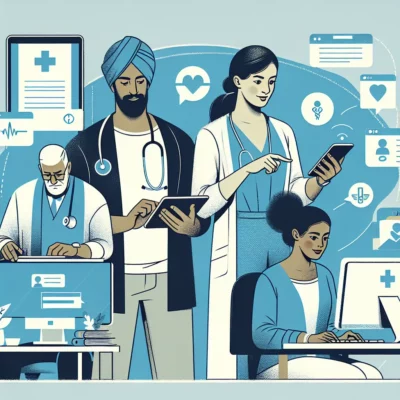The Power of Real-Time Updates
In the rapidly evolving landscape of healthcare, real-time updates have emerged as a game-changer, fundamentally altering how patients and providers interact. Real-time updates refer to the instantaneous transmission of information, ensuring that patients receive the most current data about their health status, treatment plans, and appointments. This timely dissemination of information is essential for several reasons:
- Timely Information for Patients: When patients receive up-to-date information, they can make informed decisions about their health. This is particularly crucial in managing chronic conditions where timely interventions can prevent complications.
- Facilitating Real-Time Communication: Modern technology, including mobile apps, wearable devices, and telehealth platforms, enables seamless real-time communication between patients and healthcare providers. These tools ensure that patients are always in the loop, enhancing their overall healthcare experience.
Boosting Patient Engagement
Real-time updates play a pivotal role in keeping patients informed and engaged in their healthcare journey. Here are some ways these updates enhance patient engagement:
- Keeping Patients Informed: Real-time updates ensure that patients are always aware of their health status, upcoming appointments, and any changes in their treatment plans. This constant flow of information helps patients feel more connected to their healthcare providers.
- Tools and Platforms: Numerous tools and platforms provide real-time updates, including patient portals, mobile health apps, and wearable devices. These technologies offer features like appointment reminders, medication alerts, and health monitoring, all of which contribute to increased patient engagement.
- Patient Testimonials and Case Studies: Many patients have reported feeling more involved in their healthcare due to real-time updates. For instance, a patient managing diabetes may receive real-time glucose level readings and dietary recommendations, leading to better disease management and a sense of empowerment.
Enhancing Treatment Adherence
Adherence to treatment plans is a critical factor in achieving positive health outcomes. Real-time updates significantly contribute to improving treatment adherence in the following ways:
- Reminders and Motivations: Real-time updates can include medication reminders, appointment notifications, and motivational messages. These reminders help patients stick to their treatment plans by providing timely prompts and encouragement.
- Examples of Real-Time Updates: For instance, a patient with hypertension might receive daily reminders to take their medication and weekly updates on their blood pressure trends. This constant engagement can motivate the patient to adhere to their treatment regimen.
- Supporting Data and Statistics: Studies have shown that patients who receive real-time updates are more likely to adhere to their treatment plans. According to a report by the World Health Organization, adherence rates can improve by up to 50% with the use of digital health interventions.
Personalized Patient Experience
One of the most significant advantages of real-time updates is their ability to provide a personalized patient experience. Here’s how:
- Catering to Individual Needs: Real-time updates can be tailored to meet the specific needs of each patient. For example, a cancer patient might receive personalized updates about their treatment progress, side effect management, and upcoming appointments.
- Personalized Treatment Plans: Healthcare providers can use real-time data to create and adjust personalized treatment plans. This dynamic approach ensures that patients receive the most effective and appropriate care based on their current health status.
- Role of AI and Machine Learning: Artificial intelligence (AI) and machine learning algorithms can analyze vast amounts of data to provide personalized updates. These technologies can predict potential health issues and suggest preventive measures, thereby enhancing the overall patient experience.
Overcoming Challenges
Implementing real-time update systems in healthcare comes with its own set of challenges. However, these obstacles can be overcome with the right strategies:
- Common Obstacles: Some of the common challenges include data privacy concerns, integration with existing healthcare systems, and ensuring the accuracy of real-time data.
- Solutions and Best Practices: Healthcare providers can address these challenges by adopting robust data encryption methods, ensuring seamless integration with electronic health records (EHRs), and regularly updating their systems to maintain data accuracy.
- Future Trends and Innovations: The future of real-time patient communication looks promising with advancements in technology. Innovations such as 5G connectivity, advanced wearable devices, and AI-driven health analytics are expected to further enhance the effectiveness of real-time updates.
Real-Life Success Stories
Several healthcare providers have successfully implemented real-time update systems, leading to improved patient outcomes and satisfaction. Here are some real-life success stories:
- Healthcare Provider Case Studies: A leading hospital in New York implemented a real-time update system that provided patients with instant notifications about their lab results, appointment schedules, and medication reminders. This initiative led to a 30% increase in patient satisfaction scores and a significant reduction in missed appointments.
- Patient Stories: A patient with chronic obstructive pulmonary disease (COPD) shared how real-time updates helped them manage their condition better. By receiving daily updates on their lung function and personalized exercise recommendations, they were able to maintain better control over their symptoms and improve their quality of life.
- Lessons Learned and Tips: Providers looking to implement similar systems should focus on user-friendly interfaces, ensure data security, and provide adequate training to both patients and healthcare staff. Engaging patients in the design and feedback process can also lead to more effective and widely accepted solutions.
Real-time updates are undoubtedly revolutionizing patient engagement, offering numerous benefits such as improved treatment adherence, personalized care, and enhanced patient satisfaction. As technology continues to advance, the potential for real-time updates in healthcare will only grow, paving the way for a more connected and patient-centric healthcare system.
